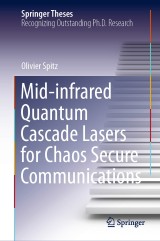Details

Mid-infrared Quantum Cascade Lasers for Chaos Secure Communications
Springer Theses
|
171,19 € |
|
| Verlag: | Springer |
| Format: | |
| Veröffentl.: | 15.05.2021 |
| ISBN/EAN: | 9783030743079 |
| Sprache: | englisch |
Dieses eBook enthält ein Wasserzeichen.
Beschreibungen
The mid-infrared domain is a promising optical domain because it holds two transparency atmospheric windows, as well as the fingerprint of many chemical compounds. Quantum cascade lasers (QCLs) are one of the available sources in this domain and have already been proven useful for spectroscopic applications and free-space communications. This thesis demonstrates how to implement a private free-space communication relying on mid-infrared optical chaos and this requires an accurate cartography of non-linear phenomena in quantum cascade lasers.<div><br><div>This private transmission is made possible by the chaos synchronization of two twin QCLs. Chaos in QCLs can be generated under optical injection or external optical feedback. Depending on the parameters of the optical feedback, QCLs can exhibit several non-linear phenomena in addition to chaos. Similarities exist between QCLs and laser diodes when the chaotic dropouts are synchronized with an external modulation, and this effect is known as the entrainment phenomenon. With a cross-polarization reinjection technique, QCLs can generate all-optical square-waves. Eventually, it is possible to trigger optical extreme events in QCLs with tilted optical feedback. All these experimental results allow a better understanding of the non-linear dynamics of QCLs and will extend the potential applications of this kind of semiconductor lasers.</div><div><br></div></div>
Introduction.- Quantum Cascade Lasers: Mid-Infrared Sources with Outstanding Features.- Chaos in Quantum Cascade Lasers.- Chaos Synchronization and its Application to Secure Communications.- Rogue Waves and Extreme Events.
Olivier Spitz received his Ph.D. in electrical engineering from Télécom Paris, France, in 2019 and is now a postdoctoral researcher with Institut Polytechnique de Paris, France, working on applications of mid-infrared quantum cascade lasers. He has been a visiting scholar in the Electrical and Computer Engineering Department of the University of California Los Angeles, USA, and in the Institut für Angewandte Physik of the Technische Universität Darmstadt, Germany. Dr. Olivier Spitz also works in collaboration with the Laboratoire de Physique of École Normale Supérieure Paris, France. His research interests include nonlinear dynamics, free-space communications, and neuromorphic photonics.
The mid-infrared domain is a promising optical domain because it holds two transparency atmospheric windows, as well as the fingerprint of many chemical compounds. Quantum cascade lasers (QCLs) are one of the available sources in this domain and have already been proven useful for spectroscopic applications and free-space communications. This thesis demonstrates how to implement a private free-space communication relying on mid-infrared optical chaos and this requires an accurate cartography of non-linear phenomena in quantum cascade lasers.<div><br><div>This private transmission is made possible by the chaos synchronization of two twin QCLs. Chaos in QCLs can be generated under optical injection or external optical feedback. Depending on the parameters of the optical feedback, QCLs can exhibit several non-linear phenomena in addition to chaos. Similarities exist between QCLs and laser diodes when the chaotic dropouts are synchronized with an external modulation, and this effect is known as the entrainment phenomenon. With a cross-polarization reinjection technique, QCLs can generate all-optical square-waves. Eventually, it is possible to trigger optical extreme events in QCLs with tilted optical feedback. All these experimental results allow a better understanding of the non-linear dynamics of QCLs and will extend the potential applications of this kind of semiconductor lasers.</div></div>
Nominated as an outstanding PhD Thesis by the Université Paris-Saclay Demonstrates how optical chaos can be exploited to provide private free-space communication Adds significantly to our understanding of the nonlinear dynamics of quantum cascade lasers
Diese Produkte könnten Sie auch interessieren:

Femtosecond Optical Frequency Comb: Principle, Operation and Applications

von: Jun Ye, Steven T. Cundiff

149,79 €















